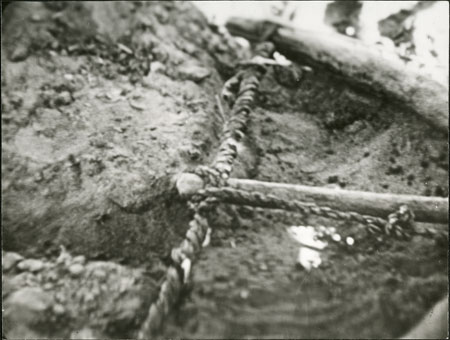Dinka animal trap

90 x 115 mm | Print silver , Selo paper
Date of Print:
1933 - 1934
Previous PRM Number:
B.7.3.5
Previous Other Number:
5
Accession Number:
1998.207.3.5
Description:
A close up of a Dinka man setting an animal trap (dang) set into the earth on a game path.
The Powell-Cotton's collected this trap, perhaps from the individual in this image, on the 3rd May 1933, and donated it to the Pitt Rivers Museum in 1934.
It is likely that this print is a still taken from the cine-film made by Powell-Cotton during this expedition.
Photographer:
Percy Horace Gordon Powell-Cotton
Date of Photo:
1933 May
Region:
[Southern Sudan] Warab Fanamweir
Group:
Dinka
PRM Source:
Percy Horace Gordon Powell-Cotton
Acquired:
Donated 1934
Other Owners:
Unknown
Class:
Hunting
Keyword:
Trap
Primary Documentation:
Notes on print reverse Ms pencil - "No 5.
Dinka Animal Trap.
Showing Bow A resting in depression in ground.
Fanamweir, Sudan 1933"
PRM Accession Records - [p. 248] 1934 [insert] 8 [end insert] - MAJOR P. H. G. POWELL-COTTON , Quex Park, Birchington, E. Kent. Specimens collected by himself & Mrs Cotton, during hunting trips, 1933, viz: - From the DINKA tribe, FANAMWEIR & KORNUK, WHITE NILE [...] [insert] 11 [end insert] - Dang , trap for antelopes etc, a very powerful bow with torsion-string of hide, stick, noose of hide, etc. ib[idem] [FANAMWEIR] (2224).
Other Information - Fanamweir is now located in the administrative district of Warab in the Southern Sudan. Powell-Cotton made ethnographic films during his 1932-3 shooting expedition to southern Sudan; footage included a Dinka hunter setting a trap: "In a game track a Dinka hunter laid a noose and set its weighty spring-trap, formed like a bow strung with twisted hide" (see the description in Mrs Powell Cotton, "Village Handicrafts in the Sudan", Man 34 (112), pp 90-91).
Dang (plural deng) is a Dinka word meaning bow (D.G. Beltrame 1880, Grammatica e Vocabolario della lingua Denka, p. 190 gives definition as 'arco, schioppo, lancia); Nebel defines the term dhang, pl. dhèng, as ‘bow, rifle’ (Nebel 1979, Dinka-English Dictionary, p. 27). See also Schweinfurth 1873, The Heart of Africa, where dang is used to described a bow-shaped type of parry shield. The Nuer also use the word to describe a type of staff with curling ends, which may be related to this form [RTS 8/11/2004].
The PRM related documents contains details of a cine film 'some tribes of the Southern Sudan', taken by Powell-Cotton during this 1933 expedition, copies of which are now in the National Film and Television Archive and the Powell-Cotton Museum in Kent [RTS 14/3/2005].
PRM Accession Records - [p. 248] 1934 [insert] 8 [end insert] - MAJOR P. H. G. POWELL-COTTON , Quex Park, Birchington, E. Kent. Specimens collected by himself & Mrs Cotton, during hunting trips, 1933, viz: - From the DINKA tribe, FANAMWEIR & KORNUK, WHITE NILE [...] [insert] 11 [end insert] - Dang , trap for antelopes etc, a very powerful bow with torsion-string of hide, stick, noose of hide, etc. ib[idem] [FANAMWEIR] (2224).
Other Information - Fanamweir is now located in the administrative district of Warab in the Southern Sudan. Powell-Cotton made ethnographic films during his 1932-3 shooting expedition to southern Sudan; footage included a Dinka hunter setting a trap: "In a game track a Dinka hunter laid a noose and set its weighty spring-trap, formed like a bow strung with twisted hide" (see the description in Mrs Powell Cotton, "Village Handicrafts in the Sudan", Man 34 (112), pp 90-91).
Dang (plural deng) is a Dinka word meaning bow (D.G. Beltrame 1880, Grammatica e Vocabolario della lingua Denka, p. 190 gives definition as 'arco, schioppo, lancia); Nebel defines the term dhang, pl. dhèng, as ‘bow, rifle’ (Nebel 1979, Dinka-English Dictionary, p. 27). See also Schweinfurth 1873, The Heart of Africa, where dang is used to described a bow-shaped type of parry shield. The Nuer also use the word to describe a type of staff with curling ends, which may be related to this form [RTS 8/11/2004].
The PRM related documents contains details of a cine film 'some tribes of the Southern Sudan', taken by Powell-Cotton during this 1933 expedition, copies of which are now in the National Film and Television Archive and the Powell-Cotton Museum in Kent [RTS 14/3/2005].
Recorder:
Elizabeth Edwards 25/1/2002 Christopher Morton 22/6/2005 [Sudan Project]
Related Collections:
PRM 1934.8.11

